|
1.
CENTRAL/ WEST AFRICA
Log prices steady through September
Throughout September, log prices remained steady.
Chinese buyers had become more selective in their
purchases, buying only Okoume and a few of the premium
red timbers. Chinese demand for lesser used species (LUS)
declined from its high position over the past two to three
years, and as a result these species are not being harvested.
Prices have weakened for these species and the prices now
quoted are at three years lows. Belli has been weakening
due to lack of demand and fell EUR45 per m3 over the last
three weeks. Onzabilli also fell by EUR24 per m3.
It is not clear whether the log quota systems in Gabon and
Congo Brazzaville have been fully implemented.
Observers believe that some producers are continuing to
negotiate with forest authorities on the volumes proposed
in the log quotas. In addition, heavy rains had been
reported in the region, handicapping harvesting and
haulage as well as restricting log supplies. The resulting
shortage of supplies has helped keep log export prices
steady.
Most lumber prices remain unchanged. Azobe has been
suffering from oversupply but sleepers have gained
EUR23 per m3 while Douka/Makopre has increased EUR
15 ¡§C EUR20 per m3. Sapele and Sipo hold on to June price
levels and are at EUR580 for GMS and EUR620-625 for
scantlings. Although overall market sentiment has been
difficult to determine, prices have been holding firm since
supply has tended to be low.
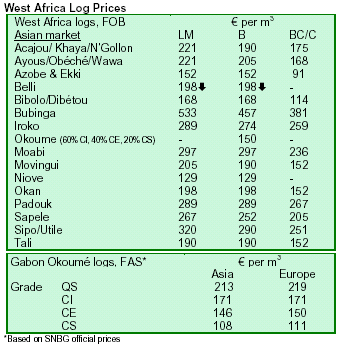
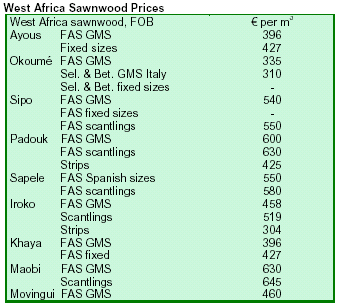
2. GHANA
EU to assist Ghanaian communities in combating
illegal logging
First Counsellor Dirk Naezer, head of the EU delegation
on Economic and Micro Trade in Ghana, recently visited
the Tema Wood Manufacturers¡¯ Association of Ghana. He
stated that the EU, in conjunction with the Forestry
Commission of Ghana (FC) and other stakeholders,
instituted a community programme to stop illegal logging
and facilitate the export of important tree species. It also
advises on how to sustain Ghana¡¯s forests while making
wood available for both the local and export markets.
The visit was to enable Naezer to ascertain the assistance
the EU could extend to the Association under the EU¡¯s
Micro and Medium Scale Sector Programme. Counsellor
Naezer, who toured various carpentry work centers, also
visited the Tema and Ashaiman timber markets where he
interacted with the workers. He observed that the wood
sector in Ghana needed more technical skills, machinery,
finance and space for operations than was envisaged. He
advised the Association to take up opportunities generated
by regional integration in order to capture the ECOWAS
market. Counsellor Naezer commended the carpenters for
producing quality products under strenuous conditions and
assured the wood workers of support after consulting with
the Ghana authorities.
Rainfall facilitates implementation of Modified Taungya
System
In 2002, the Government, through the Ministry of Lands,
Forestry and Mines, launched the Modified Taungya
System, which is aimed at replenishing degraded portions
of some forest reserves in the country and alleviating
poverty in rural communities. Good levels of rainfall this
year have facilitated the development of the Modified
Taungya System in the country. Officials are very
confident that they could complete the remaining 20% of
the targeted 3,500 hectares of degraded forests earmarked
for replanting this year. The programme will continue until
all the degraded portions are planted with various tree
species.
In the Ashanti region, some of the tree species include teak
and indigenous species like Cedrela, Ofram, Emire, Ceiba,
Mahogany, Mansonia, Koto and Wawa. The Forest
Services Division (FSD) of the FC and the forest fringe
communities have been engaged in the project aimed at
meeting their planting targets for the year. The Ashanti
region forms a major part of the project because parts of
forest reserves in the region have been destroyed by
bushfires. A number of forest reserves engaged in the
Taungya System are in the Kumawu, Kwame Nkawie,
Juaso/Bekwai and Offinso Forest Districts.
The FSD offers the communities land from the degraded
parts of the forests where they plant their food crops. The
FSD also offers technical advice to the farmers on
nurturing the trees to maturity while they still farm on the
lands. On maturity, the farmers are entitled to 40% of the
standing value of the planted trees.
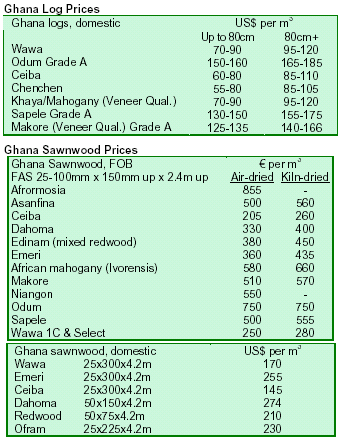
3.
MALAYSIA
Malaysia amends forestry act to tighten legality provisions
Bernama reported on how Malaysia expects to strengthen
its laws to fight illegal logging. Deputy Prime Minister
Najib Razak, the Chairman of the National Forestry
Council, said logging companies will have to provide
documentary evidence they are not harvesting illegally. He
said the Council agreed to review and amend the National
Forestry Act as to transfer the ¡®burden of proof¡¯ to those in
possession of timber. Deputy Prime Minister Razak noted
that illegal logging had an impact on biodiversity and
global warming and was negatively affecting the image of
the country. He said that if Europe and the US were to
pursue legal action, this could have adverse effects on
Malaysia¡¯s economy.
Investments in ECER cover furniture making activities
The news agency Bernama reported that the East Coast
Economic Region (ECER), covering the Peninsular
Malaysian states of Kelantan, Terengganu, Pahang and
Mersing district in Johor, will receive RMB44.8 billion to
spend on major transportation linkages and other
infrastructure. Petronas President and CEO Tan Sri Mohd
Hassan Marican said the investments would be a critical
determinant of fostering regional development and growth.
Hassan noted that part of the funds would be used to
revitalize the agriculture sector, including growing rubber
trees for timber used in furniture making. He explained
that 50,000 to 100,000 acres have been secured for
growing rubber trees for timber and that the region could
now expand its furniture making activities.

4.
INDONESIA
LEI leads ventures on certified timber and handicrafts
Antara News reported on the Indonesian Ecolabeling
Agency¡¯s (LEI) establishment of joint ventures to provide
certified timber products and handicrafts to the
international furniture market. LEI has teamed up with
forest management groups in the Wonogiri district in
Central Java and Gunungkidul district in Yogyakarta and
the Indonesian Furniture and Handicraft Industry
Association (Asmindo). A LEI spokesperson said that
products that have eco-labels will enter the furniture and
handicraft markets in the near future.
At a workshop where the LEI scheme was announced, an
executive from the American Sustainable Furniture
Council said that the US market, with an estimated market
worth USD84.2 billion in 2006, was heightening its focus
on products from certified forests. Indonesian Furniture
Association Chairperson Ambar Tjahyono said that the
high cost of obtaining eco-labelling certification, currently
estimated at Rp100 million, was a hindrance to the
progress of the eco-labelling programme. She added that
Indonesian furniture and handicraft exports were worth
USD2.4 billion in 2006. She commented that Indonesia¡¯s
furniture and handicraft industry required about 10 million
m3 of timber from state forestry firm PT Perhutani and 4.5
million m3 from public forests.
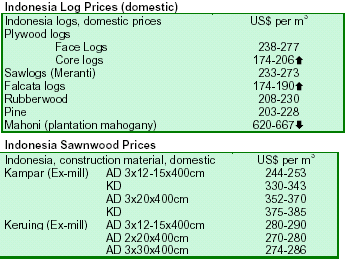
5.
MYANMAR
Protests in Rangoon escalate
The BBC reported on the protests in against the Myanmar
government, which were started in opposition to price
hikes for fuel. As a result, prices for transport and staples
have skyrocketed. Buddhist monks had increasingly joined
public protests after troops broke up a peaceful
demonstration in Pakkoku. The UN Security Council
urged the government to welcome the UN special envoy
Ibrahim Gambari to the country as soon as possible in an
effort to ameliorate the situation.
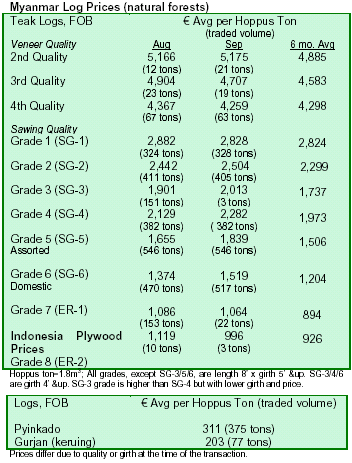
6. BRAZIL
Brazil sets annual interest rate set of 11.25%
The Consumer Price Index (IPCA) increased 0.47%,
almost double that in July 2007. The Monetary Policy
Committee (COPOM) met in early September and reduced
the prime interest rate (SELIC) by 0.25% percentile
points, resulting in an annual rate of 11.25%.
Exports from North Brazil to surpass 40% of total
exports
The Society of Ports and Waterways (Soph) estimated that
veneer and plywood exports through the Port of Porto
Velho (the capital of state of Rondoia) are expected to
surpass about 40% of total exports to foreign markets in
2007. According to Diaio da Amazoia, Porto Velho Port
has received massive investment in machinery, equipment
and logistic infrastructure since 2003, resulting in
optimization and cost reduction of shipping. Finished
lumber is dispatched preferentially from the quays and
moorings, instead of being transported by trucks to the
ports of Santos and Paranagu? located in Southern Brazil.
The State Secretariat of Agriculture, Production,
Economic and Social Development (SEAPES) has worked
to reduce cost and time in loading and unloading at the
Madeira River Hydroway.
Currently, the main importing markets of the wood
products from the state are the US, Europe and Asia. The
main species exported through the Northern Brazilian
states of Rondoia and Acre have been Ip? Cumaru,
Tauari, Jatob? Tamarindo, Roxinho and Maracatiara.
New forest concessions will boost certified wood by
50%
Folha de Sao Paulo reported on the federal government¡¯s
announcement to approve the first forest concessions in
the Northern State of Rondonia.The first concessions for
wood production in Amazonian public reserves will begin
in 2008 within the Jamari National Forest, an area of
90,000 hectares. The concessions will support the solid
wood sector, which accounts for an annual revenue of
USD2.5 billion.
The operations will aim to protect 10% of the forest and
generate income. The concessions will also likely increase
the volume of certified (FSC) timber into the market.
Currently, certified forests represent less than 5% of the
total forest area. It is estimated that forest concessions and
the ecological zones will increase the volume of certified
wood from the region to 50%.
Brazilian project to target illegal wood use
The Sao Paulo Secretariat of the Environment is to start a
project on deforestation, which will restrain the entrance
and commercialization of illegal wood in southern
regional states, said Folha da Sao Paulo. The objective of
the project is to intensify the control of native wood
transportation, mainly from Amazonia, in the bordering
states of Mato Grosso do Sul, Minas Gerais and others.
The operations will involve police blockades to inspect the
Document of Forest Origin (DOF) and the production of a
forest guide to classify and identify wood origin.
Every year, 24 million m?of logs are extracted from the
Amazonia rainforests, of which approximately 15% are
destined for the Sao Paulo market. This makes the Sao
Paulo State the world's largest consumer of Amazonian
native timber, with 3.6 million m?distributed to wood
warehouses and consumed by diverse sectors of the Sao
Paulo economy. To execute the project, the government
will stimulate consumption of timber from planted forests
and award those companies utilizing wood from
sustainable origins.
American hardwood specialists target Brazilian market
Remade reported that specialists from the American
Hardwood Export Council attended workshops in Brazil
during September 2007. The events were to highlight the
importance of American wood and to incorporate
American standards in the production of Brazilian
furniture for the American market. The events were
designed for entrepreneurs of the wood and furniture
sectors and were held in the three southern region states
(Rio Grande do Sul, Santa Catarina and Parana.
American hardwoods are well known worldwide for their
aesthetic characteristics, sustainability and resistance.
Brazil exported USD 300 million of furniture in 2006 to
the US, where the demand for finished products with
American wood, especially red oak, is increasing. In the
same year, the American market absorbed USD12 billion
worth of furniture manufactured in China, mostly with
American raw material.
Exports of wood products show modest growth
Exports of general wood products (except pulp and paper)
rose 5.3% in August 2007 compared to the same period in
2006. Total exports during August reached USD398.4
million. Pine sawnwood fell in volume by 6.2%, from
136,610 m3 in August 2006 to 128,108 m3 in August
2007.Tropical sawnwood exports rose in value by 27.8%
and volume by 11.9%. Although the volume of pine
plywood decreased 23.7%, it rose 1.8% in value in August
2007. Tropical plywood rose in value and volume, by
19.1% and 10.6%, respectively.
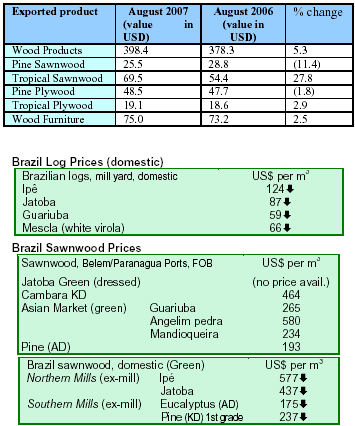
7.
PERU
Semi-manufactured products and furniture featured
high in Peruvian exports
From January to July 2007, wood sector exports rose
5.51% by value, rising from USD120.3 million to
USD114.0 million. In July 2007, however, exports fell
USD3.1 million compared to those for July 2006. Items
with the highest volume exported in January to July 20007
were semi-manufactured products and furniture and its
components, which rose 18.83% and 17.08% by volume
respectively. Among the products with decreasing exports
were: building components (-6.92%); manufactured
products (-2.68%); and veneers and wood sheets (-
92.10%).

Peru exports rise 13.49% in first semester
During the first semester of 2007, Peru¡¯s manufactured
solidwood products exports amounted to USD102.9
million, rising 13.49% compared to the same period in
2006. The rise was mainly due to semi-manufactured
products exports, which increased 31%, reflecting sales
worth USD26.8 million. In the same period, the tariff
consignments on furniture and its parts were valued at
USD8.4 million, jumping 19.24% compared to the same
period in 2006. The rising values of lumber and furniture
exports reflect the increasing importance of the country¡¯s
production of greater value-added wood products.
The main product exported, sawnwood, represented
52.24% of the total share of exports by value. Veneer and
plywood also rose 4.11% during the first half of this year.
Fiberboard and particleboard exports decreased 82.08%,
while exports of firewood and charcoal fell 90.80%. The
decline in these products was caused by heightened local
demand, as products normally exported were redirected to
the local market.
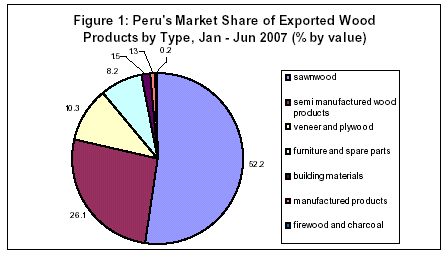
US, Mexico and China main importers of Peru wood
products
Continuing the trend of the last three years, the three main
destinations of Peru wood products during the first half of
2007 were the US, Mexico and China. Exports to the US
decreased 8.36% by value, dropping from 39.51% in 2006
to 34.32% in 2007. Mexico¡¯s share of imports increased
19.22%. Peru¡¯s market share reached 30.56%. Peru¡¯s share
of the Chinese market for wood products was 20.0%,
similar to that in 2006.
During the first semester of 2007, exports to the US
increased 3.61%, but total market share decreased from
38.1% to 34.8%. Mexico was the second largest importer,
with imports holding 29.1% of the market. Spain and
Sweden are also destinations where imports of Peru wood
products have increased in the first semester. In total, Peru
wood products were exported to more than 60 countries
worldwide.
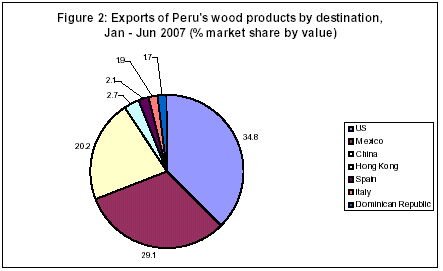
Agreement reached on forestry aspects of US-Peru
FTA
In the past few weeks, Peru and the US have reached
agreement on the forestry aspects of the US-Peru Free
Trade Agreement. Both countries have been aware that
illegal trade of lumber and wildlife undermines the trading
of forest products from legal sources, thereby reducing the
real economic value of renewable natural resources and
weakening efforts to promote resource conservation and
their sustainable management. Both countries
acknowledged the importance of sustainable management
in the forestry sector to promote economic value of forests
and sustainable resource management. Peru and the US are
committed to do what is needed to improve the
management of the forestry sector and to promote legal
trade in forest products.
Within 18 months of the FTA¡¯s implementation, Peru
must strengthen the management of its forestry sector. The
following actions will need to be undertaken: increase the
staff in charge of enforcing legal directives, leading to a
substantial reduction in illegal logging and illegal trade;
persuade those who undermine or obstruct the sustainable
management of forestry resources by imposing penal or
civil repercussions; and adopt and implement necessary
measures for the monitoring of the distribution and
conditions of tree species included in CITES listings.
Peru must also include in its annual export quota only
broadleaved mahogany forest species extracted from
native communities or forest concessions with an annual
operative plan approved and verified by INRENA and
supervised by OSINFOR. The country must also design
verification systems to assess the legal origin and the chain
of custody for species included in CITES listings. Systems
must also be designed to ensure traceability of specimens
from logging, forwarding, processing and exportation.
Finally, Peru must carry out periodic audits on producers
and exporters specializing in US markets and check if their
products comply with the regulations on logging and
trading of forest products, including those found in
Appendix II of CITES.
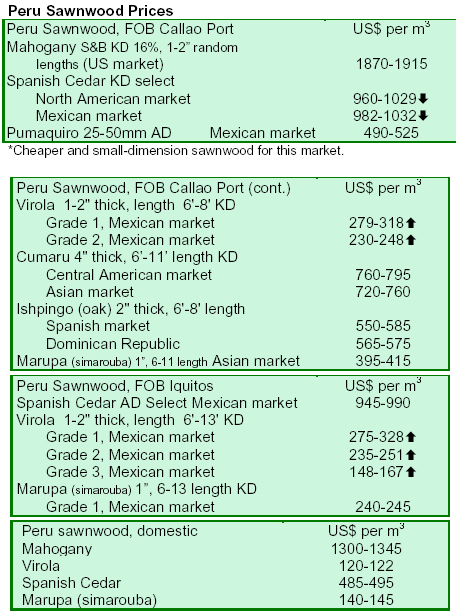
8.
BOLIVIA
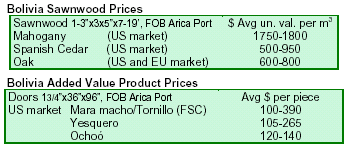
9.
GUYANA
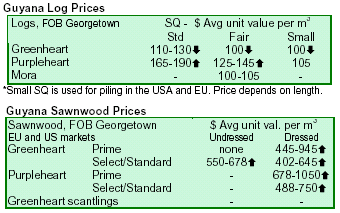
|